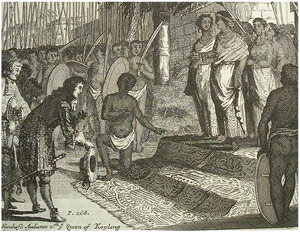Dutch fort in Cochin.
Queen Gangadhar Lekshmy is under arrest.
Move by the Dutch to enthrone a new King.
Kings to help and oppose Cochin.

1662
The Dutch With New Strategies Against the King of Cochin
Van Goens and his group voyaged over Vaipin Island after the seventh day of the capture of the fort of Cranganore with an aim to seize it. Reaching the other side of the island they erected a temporary fort there christening it as 'New Orange'.
The Dutch then planned to attack the fort possessed by the Portuguese one and half century ago. The fort which has been the one constructed in India ever by an European power was named Fort Manuel after the Portuguese king in honour of him. The rise and growth of the Portuguese was from there. Now with an aim to drive them out from Kerala another European power, the Dutch has come over here. The name the Dutch gave the new small fort constructed by them with an aim to seize Fort Manuel was nothing but the name of the royal dynasty of Netherland.

They launched their attacks from the Fort of New Orange towards the centre and encampments of the Portuguese .The Eldest Lord of Cochin, in the meanwhile, came with the help needed by the Dutch making arrangements for gathering food items for them. The Portuguese became perplexed .They had already estimated the danger inherent in the loss of the fort of Cranganore. Lord Gotha Verma, the king of Cochin, and Sarmanto, the Portuguese governor, and officials were racking their brains .Though there arose an opinion to pounce upon the Dutch no decision was taken. In the meanwhile Van Goens landed ashore and walked into St. Iago Church along with the fighters and then on the following day escaped to Mattanchery. He was constrained to fight off the war-whooping Nair troops who took shelter in the nearby temple unable to face the fire power of the guns of the Dutch. Queen Gangadhar Lekshmi was arrested and brought under the custody of the Dutch. Following the arrest the Raja of Purakkad, the friend of the Portuguese came over with troops at Cochin. The Dutch started besieging the fort on three sides, under the commandership of Isbrand Gostie and Roothbans. The Portuguese started to crush the strategies of the Dutch and they got supplies and reinforcements from Goa and this resulted in the withdrawal of the Dutch from the scene. They started pondering over the strategies to reconquer the fort of Cochin after making arrangement for the protection of the forts, Cranganore and New Orange.
The very moment the Dutch started attacking Mattanchery Gotha Verma, the Raja of Cochin, escaped to Muttam (Chertalai). Coming to know of the stoppage of the siege of Cochin by the Dutch, he came back elated and festive with an entourage of 700 Nair soldiers. The town-dwellers received him with ululation and drum-beating without knowing that the Dutch was scheming to dethrone him and take back Cochin fort.
Nieuhoff in the palace of the Queen of Quilon.
The last attempt to take over Cochin.
The Dutch Flag on the Fort of Thankassery.

Queen of Koylang [Quilon]
Nieuhoff was appointed as the Chief Director to enter in to agreements with the kings of south Kerala when the Dutch was awaiting an immediate opportunity to takeover Cochin. He was travelling by a ship to Quilon via Kayamkulam. On board with him being Kerala Verma, belonging to the elder branch of the Matriarchy of the Cochin royalty whom the Dutch had planned to crown as the king. Kerala Verma who should have been the king of Cochin kingdom had earlier sought the help of the Dutch by visiting them at Colombo. Reaching at Quilon, Nieuhoff attempted first to repair the fort of Thankassery and to furnish houses for the Company's servants. Then he started making trade treaties with the Queen of Quilon and other officials. He recorded that the town in which the queen lived had a fort wall of height of 18 or 20 feet and that the beautiful place inside the palace was called 'Kollam China'. The part of the territory, where royal palaces and palacious buildings were situated, was called Upper Quilon and that part of the territory by the sea where St. Pauls Church and monasteries were situated was called Lower Quilon. The town-dwellers built beautiful houses with stones. The residential building of the governor was a two-storied palace with two of its gate towers thatched while another one being tiled. Nieuhoff recorded that this fort was constructed by Hector de Lakasa in 1552. Nieuhoff and his group transformed the office of the governor as their place of residence. They hoisted the Dutch flag atop the squarish gate tower.
When the Dutch forces were readied themselves to besiege the fort of Cochin, the king Kerala Verma was staying with Nieuhoff. Soon he was afflicted with disease.
Nieuhoff informed this to the Queen of Quilon. Following that, his residence was shifted to the palace of the Queen. Hower, the disease had not shown any sign of subsidence even after the shifting. In the meanwhile, news reached in Quilon that the Dutch completed arrangements to besiege Cochin.